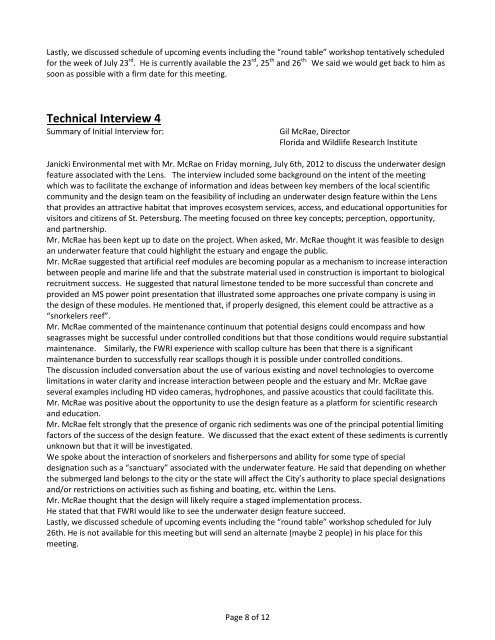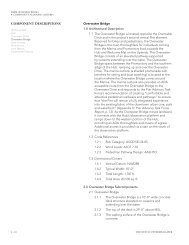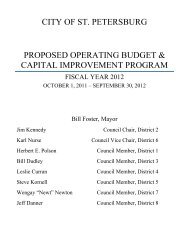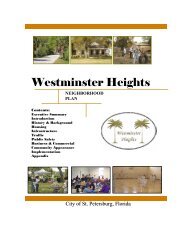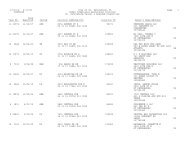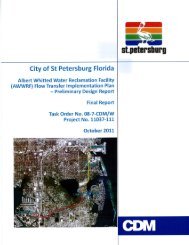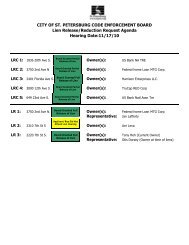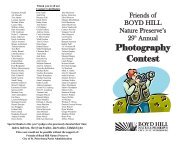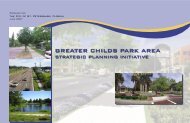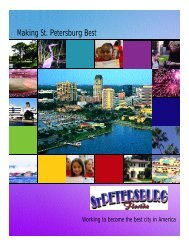Basis of Design Book 2 - City of St. Petersburg
Basis of Design Book 2 - City of St. Petersburg
Basis of Design Book 2 - City of St. Petersburg
Create successful ePaper yourself
Turn your PDF publications into a flip-book with our unique Google optimized e-Paper software.
Lastly, we discussed schedule <strong>of</strong> upcoming events including the “round table” workshop tentatively scheduled<br />
for the week <strong>of</strong> July 23 rd . He is currently available the 23 rd , 25 th and 26 th. We said we would get back to him as<br />
soon as possible with a firm date for this meeting.<br />
Technical Interview 4<br />
Summary <strong>of</strong> Initial Interview for:<br />
Gil McRae, Director<br />
Florida and Wildlife Research Institute<br />
Janicki Environmental met with Mr. McRae on Friday morning, July 6th, 2012 to discuss the underwater design<br />
feature associated with the Lens. The interview included some background on the intent <strong>of</strong> the meeting<br />
which was to facilitate the exchange <strong>of</strong> information and ideas between key members <strong>of</strong> the local scientific<br />
community and the design team on the feasibility <strong>of</strong> including an underwater design feature within the Lens<br />
that provides an attractive habitat that improves ecosystem services, access, and educational opportunities for<br />
visitors and citizens <strong>of</strong> <strong>St</strong>. <strong>Petersburg</strong>. The meeting focused on three key concepts; perception, opportunity,<br />
and partnership.<br />
Mr. McRae has been kept up to date on the project. When asked, Mr. McRae thought it was feasible to design<br />
an underwater feature that could highlight the estuary and engage the public.<br />
Mr. McRae suggested that artificial reef modules are becoming popular as a mechanism to increase interaction<br />
between people and marine life and that the substrate material used in construction is important to biological<br />
recruitment success. He suggested that natural limestone tended to be more successful than concrete and<br />
provided an MS power point presentation that illustrated some approaches one private company is using in<br />
the design <strong>of</strong> these modules. He mentioned that, if properly designed, this element could be attractive as a<br />
“snorkelers reef”.<br />
Mr. McRae commented <strong>of</strong> the maintenance continuum that potential designs could encompass and how<br />
seagrasses might be successful under controlled conditions but that those conditions would require substantial<br />
maintenance. Similarly, the FWRI experience with scallop culture has been that there is a significant<br />
maintenance burden to successfully rear scallops though it is possible under controlled conditions.<br />
The discussion included conversation about the use <strong>of</strong> various existing and novel technologies to overcome<br />
limitations in water clarity and increase interaction between people and the estuary and Mr. McRae gave<br />
several examples including HD video cameras, hydrophones, and passive acoustics that could facilitate this.<br />
Mr. McRae was positive about the opportunity to use the design feature as a platform for scientific research<br />
and education.<br />
Mr. McRae felt strongly that the presence <strong>of</strong> organic rich sediments was one <strong>of</strong> the principal potential limiting<br />
factors <strong>of</strong> the success <strong>of</strong> the design feature. We discussed that the exact extent <strong>of</strong> these sediments is currently<br />
unknown but that it will be investigated.<br />
We spoke about the interaction <strong>of</strong> snorkelers and fisherpersons and ability for some type <strong>of</strong> special<br />
designation such as a “sanctuary” associated with the underwater feature. He said that depending on whether<br />
the submerged land belongs to the city or the state will affect the <strong>City</strong>’s authority to place special designations<br />
and/or restrictions on activities such as fishing and boating, etc. within the Lens.<br />
Mr. McRae thought that the design will likely require a staged implementation process.<br />
He stated that that FWRI would like to see the underwater design feature succeed.<br />
Lastly, we discussed schedule <strong>of</strong> upcoming events including the “round table” workshop scheduled for July<br />
26th. He is not available for this meeting but will send an alternate (maybe 2 people) in his place for this<br />
meeting.<br />
Page 8 <strong>of</strong> 12


